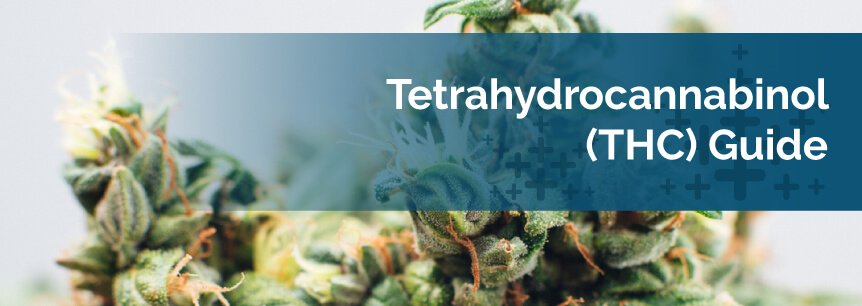
Medical marijuana is becoming more prominent as a treatment for disease and chronic debilitating conditions. In some places, there is a stigma some users must overcome. One compound in marijuana called THC, or tetrahydrocannabinol, takes most of the blame for the negative view of marijuana in the US.
But the same THC that can make you high also has positive health benefits. People suffering from debilitating diseases who cannot find relief from their symptoms in any other way are learning they can turn to marijuana as an effective treatment. With continued research, medical science can better understand and make use of the psychoactive mechanisms in THC for advanced healing.
THC is perhaps the most well-known chemical compound found in the cannabis plant. All varieties of cannabis contain THC, although some contain very little and others are THC dominant. THC is referred to as a cannabinoid for its role in making up the cannabis plant.
Marijuana has been used for medicinal purposes for centuries in various cultures across the globe. In modern times, it rose to prominence in the American drug subculture in the 1960s. Research studies done at the time concluded that cannabis use did not lead to more serious drug use or violent behavior.
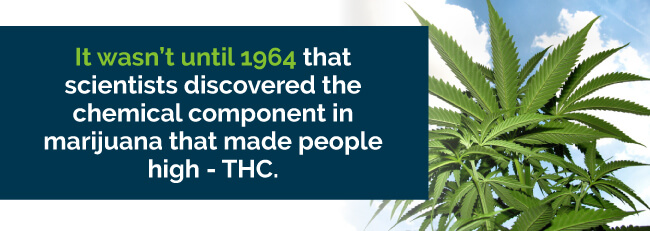
It wasn’t until 1964 that scientists discovered the chemical component in marijuana that made people high – THC. A synthetic version of THC, dronabinol, was developed and marketed in the US and Canada. Marinol, trade name for dronabinol, is clear or amber-colored and becomes oily and sticky when heated.
THC is believed to protect the cannabis plant from UV rays and herbivores. It is considered an aromatic terpenoid, part of the phytocannabinoid family. THC is not soluble in water but mixes well with lipids and alcohol. When consumed, THC binds with cannabinoid receptors in the central nervous system and brain to produce a euphoric effect.
Cannabinoid receptors exist in the brain to work with the endogenous cannabinoids the body naturally produces. Natural cannabinoids produce a mild euphoric feeling when they are produced in abundance, such as at the end of a good workout. THC inserts itself in this natural pathway to euphoria and increases those positive effects.
Cannabinoid receptors are associated with memory, pleasure, thinking, time perception, and coordination. All these functions can be affected by the detection of THC at the receptor sites. The exact effect depends on the amount of THC consumed, the level of natural cannabinoids in the system, and several other health variables.
When THC is consumed in its natural form, it is accompanied by other chemical elements of the cannabis plant. One other prominent component of marijuana, CBD, blocks the effects of THC. Each cannabis plant has a different ratio of THC to CBD, so the euphoric effects may be tempered by this balance.
Like all drugs, when THC enters your bloodstream and reaches your brain, it inserts itself in several communication pathways. This is how THC changes your mood to the euphoric state described by users.
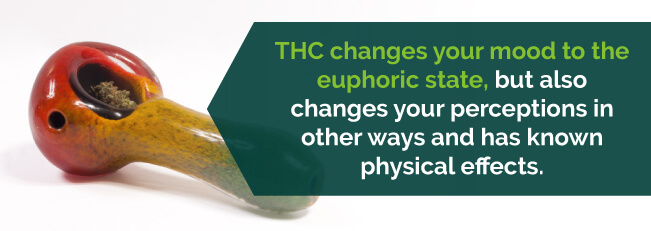
THC also changes your perceptions in other ways and has known physical effects, a few of which are:
Studies continue to reveal new benefits of THC, but these are the predominant effects of current high-THC strains of marijuana.
The synthetic version of THC, dronabinol, is marketed by prescription only, for relief of nausea and vomiting associated with cancer treatment. It is also used as an appetite stimulant for patients battling AIDS and to relieve the pain for multiple sclerosis patients.
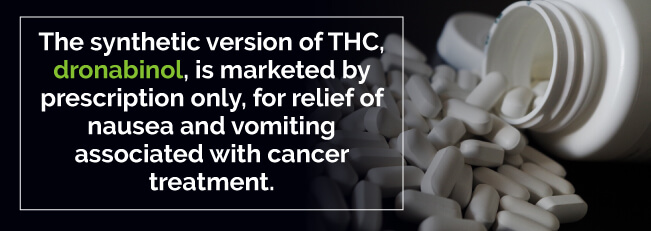
The THC found in medical marijuana has several medical applications when used in its natural form, including:
Marijuana has no real health or overdose risks, and once a patient is off opioids, it is much easier to step-down the marijuana until the addiction is eliminated.
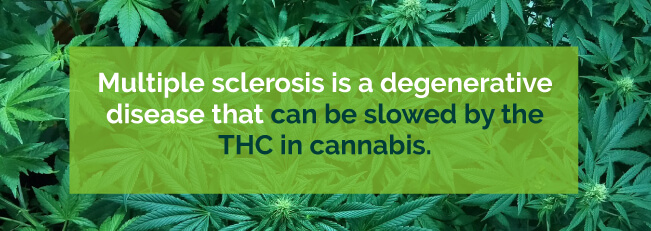
This is just a sample of the conditions for which THC can be a useful treatment. As research continues into the effects and uses of THC, more applications will likely be discovered.
Every substance you put in your body has an effect and a side-effect. The side-effects are the results you do not want and can vary from drug to drug. Some drugs have severe side-effects, but we use them because the potential benefits outweigh the risks.
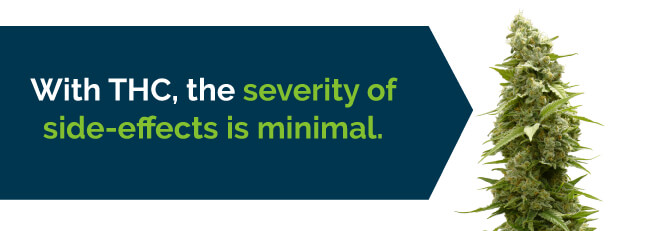
With THC, the severity of side-effects is minimal. In fact, some of these side-effects may not be considered detrimental at all.
There is some question to whether THC is addictive. Any substance can become addictive due to the mental and emotional side of addiction. If marijuana becomes addictive, it is primarily due to the THC content. The psychoactive properties of THC produce a euphoric effect that your brain could crave.
An addiction to marijuana has fewer health risks than many other drugs. Cannabis offers health benefits, so using it responsibly will not deteriorate your physical condition. A proper balance of THC and CBD can reduce stress, improve mood and heal brain injury.
The impact THC has on the pleasure centers in your brain is not nearly as strong as opioids. The desire to use more marijuana is usually tempered with the relaxation effect that calms anxiety and renders sleep.
The most accessible form of THC is found naturally in cannabis where it is tempered with other natural cannabinoids. Although there are three main strains of the cannabis plant, there are hundreds of hybrid strains, making it a little more difficult to find the THC you are looking for.
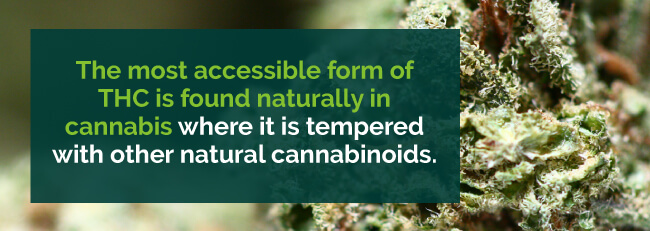
Of the three main types of cannabis — indica, sativa and ruderalis — sativa has the highest THC content. Hybrid strains that are sativa dominant are the ones you want to look for in your THC therapy. Here are some of the popular ones:
|
Strain |
THC |
Conditions Relieved |
|
Girl Scout Cookie |
17-28% |
stress, pain, depression, lack of appetite, headaches |
|
The White |
18-29% |
stress, pain, insomnia, depression, lack of appetite |
|
Death Star |
20-24% |
stress, pain, insomnia, depression, muscle spasms |
|
Gorilla Glue #4 |
25-29% |
stress, pain, depression, insomnia, lack of appetite |
|
Bruce Banner #3 |
29% |
depression, stress, pain, fatigue, nausea |
|
Blissful Wizard |
28-34%% |
nausea, insomnia, pain, stress lack of appetite |
|
Tutankhamun |
28-30% |
depression, stress, pain, insomnia, fatigue |
|
Ghost Train Haze |
27% |
depression, stress, pain, fatigue, headaches |
When you find a strain of medical cannabis that has the THC level you need and affects the conditions you are concerned about, you are on your way to beginning THC treatments. The next step is to find a delivery system that works best for your situation.
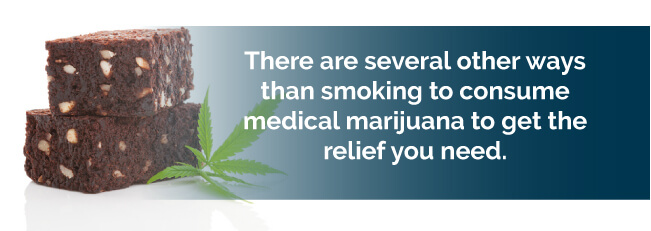
Marijuana does not have to be smoked to gain the medical benefits. There are several other ways to consume medical marijuana to get the relief you need.
Concentrates can act quickly when placed under the tongue to be absorbed into the bloodstream. THC administered this way goes immediately to the brain and reduces symptoms like nausea instantly.
A marijuana doctor can help you match the proper healing strain of cannabis to your diagnosis and suggest a dosage for you to begin with. When you go to a dispensary to purchase your medical marijuana, the staff there can teach you different ways of taking medical marijuana and find the delivery system you feel comfortable with.
The Federal Food and Drug Administration (FDA) has approved a couple synthetic THC drugs for use with prescription on a limited number of conditions. Marijuana, which contains THC naturally, is still banned by the FDA.
As the psychoactive component to cannabis, THC is the reason marijuana was banned in the mid-1900s. There was concern about addiction and the prevalence of recreational marijuana users in the US, especially around the time of the Vietnam War, and drugs that can make you high were targeted by President Nixon’s war on drugs.
More recently, many states have promoted a medical marijuana program that allows controlled use of cannabis products for medical purposes only. These programs are carefully monitored by state agencies that track the patients, doctors and suppliers.
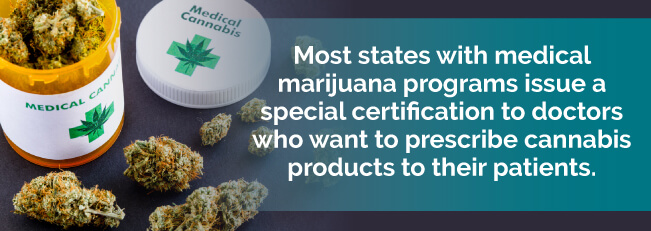
Most states with medical marijuana programs issue a special certification to doctors who want to prescribe cannabis products to their patients. Doctors receive special training in the accepted uses of medical marijuana and what conditions it can be used to treat.
Patients in those states need to register for the medical marijuana program and are only given access to the medicine if a doctor certifies that they are suffering from a condition that can be improved by cannabis and not by any other means. These states also collect data on which conditions are treated by which strain and if the treatments were successful.
Medical marijuana states regulate the cultivation of cannabis and the production of medical-grade products. In some states, only low-THC cannabis is acceptable for distribution to eligible patients. Dispensaries must verify the patients are registered in the medical marijuana program, and there are limits on how much marijuana product they can sell to an individual at one time.
Because THC is still banned by Federal law, doctors in medical marijuana states do not write prescriptions for the medicine. A marijuana doctor makes a recommendation for cannabis therapy and enters it into the state-wide database with the registered patient’s account. The dispensary has access to this information from the database and can confirm and fill the doctor’s recommendation at the patient’s request.
The possession and transportation of THC or any marijuana product in public is against Federal law, even where states allow it. Some states have begun to set up dispensary delivery services so patients can receive their medical marijuana at home. The dispensaries are licensed and secured to carry the medicine for medical deliveries.
If you’d like to learn more about the THC legislation in your state or would like help contacting a dispensary, contact Marijuana Doctors today!


Please allow us to access your location to find local dispensaries.
VIEW ALL DISPENSARIES ➔